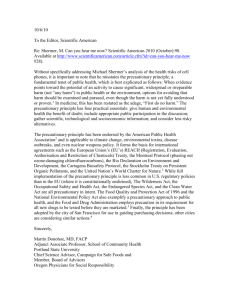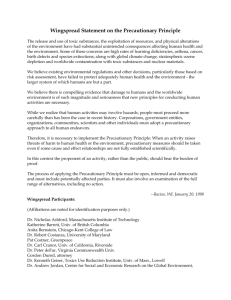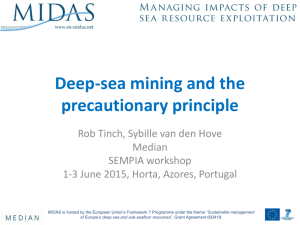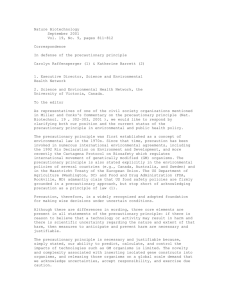Environmental Ethics It's Not Just for Environmental Engineers
advertisement
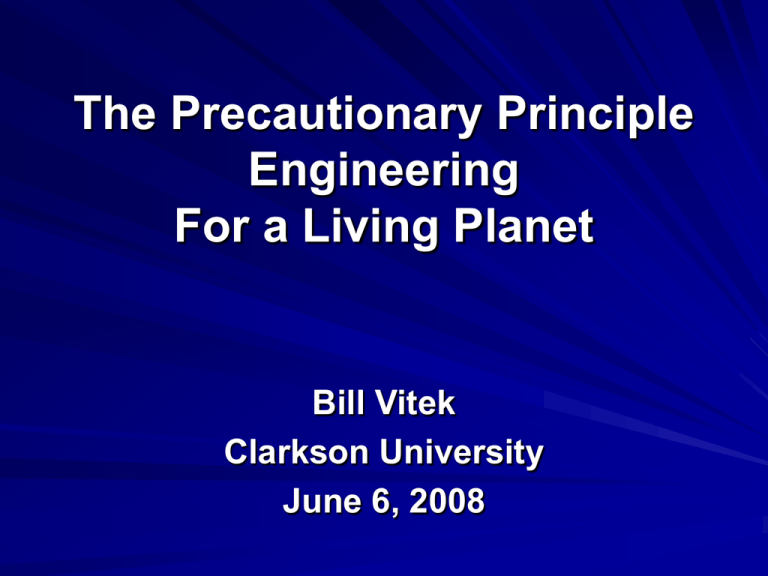
The Precautionary Principle Engineering For a Living Planet Bill Vitek Clarkson University June 6, 2008 OUTLINE The Emerging Ecospheric Paradigm The Precautionary Principle The Precautionary Principle and the Engineering Code of Ethics 21st Century Engineering – Ecospheric – Precautionary – Visionary Presentation Objectives Introduce the Precautionary Principle as a new and powerful alternative to risk management. Connect the Precautionary Principle to the core principles of the NSPE’s Code of Ethics for Engineers. Presentation Objectives Facilitate a dialogue among workshop participants on the viability of integrating the Precautionary Principle into the Code of Ethics as a “Fundamental Canon. Demonstrate the value of such dialogues in ethical and professional development. What is Engineering? “Engineering…is the direction of the sources of the power of nature for the use and convenience of man. It is the link, the bridge between man and nature; a bridge over which man passes into nature to control it, guide it, understand it, and the bridge over which nature and its forces pass to get into man’s field of interest and service” Nicholas Murray Butler, Nobel Laureate and President of Columbia University, 1901-1945 Engineering Assumptions Mind-Reality Interface Knowledge is Possible Knowledge is Power Divide and Conquer Nature is Passive The Whole is Equal to the Sum of its Parts Assumptions Continued Technical and Scientific Knowledge are Value Free All Mistakes are Fixable “Cross that bridge when we come to it” Knowledge accumulates and drives out ignorance What is Engineering? “Engineering is the art of modeling materials we do not wholly understand, into shapes we cannot precisely analyze so as to withstand forces we cannot properly assess, in such a way that the public has no reason to suspect the extent of our ignorance.” A.R. Dyes, British Institution of Structural Engineers, 1976 Assumptions Challenged Nature is not passive Whole not equal to the sum of the parts Knowledge is not value free Ignorance increases with increased knowledge Some mistakes are less fixable than others Greater Knowledge=Greater Responsibility Engineering and Environmentalism Sources: 1880’s-1940’s – Conservation Sinks: 1950’s-1980’s – Pollution Control Systems: 1990’s-Present – Sustainability – Life Cycle Analysis – Industrial Ecology An Ecospheric Ethos Engineering* is a tool for living well in the world. This world is alive, interconnected and crowded. The tool is limited by ethics, ignorance, and the net primary production of ecosystems. * Or science, politics, economics, etc. 21st Century Professional Engineers Green Engineering Principles The Earth as a living system Precautionary The Precautionary Principle History – Hippocrates (5th Century BCE): “Do No Harm” – Public Health – Germany in 1970’s: “Vorsorgenprinzip” or “Forecaring Principle” The Precautionary Principle Definition from 1992 Rio Conference "In order to protect the environment, the precautionary approach shall be widely applied by States according to their capabilities. Where there are threats of serious or irreversible damage, full scientific certainty shall not be used as a reason for postponing cost-effective measures to prevent environmental degradation." Ref: http://habitat.igc.org/agenda21/rio-dec.html Principles People have a duty to take anticipatory action to prevent harm. "If you have a reasonable suspicion that something bad might be going to happen, you have an obligation to try to stop it.” The burden of proof of harmlessness of a new technology, process, activity, or chemical lies with the proponents, not with the general public. Source: http://www.sdearthtimes.com/et0398/et0398s4.html Principles Before using a new technology, process, or chemical, or starting a new activity, people have an obligation to examine "a full range of alternatives" including the alternative of doing nothing. Decisions applying the precautionary principle must be "open, informed, and democratic" and "must include affected parties." Source: http://www.sdearthtimes.com/et0398/et0398s4.html Applications Explore alternatives to possibly harmful actions, especially “clean” technologies that eliminate waste and toxic substances Set and work toward goals that protect health and the environment Bring democracy and transparency to decisions affecting health and the environment. http://www.sehn.org/ppfaqs.html The Precautionary Principle In action – EPA and OSHA in 1970’s – Canada: Federal Policy (2003) – Quebec Pesticide Laws (2002) – American Public Health Association endorsement (2000) – Mendocino County begins precautionary principle pilot programs (2007) The Precautionary Principle In action – Principles for the Oversight of Nanotechnologies and Nanomaterials (2007) – U.S. Green Building Council's Guiding Principles Include Precaution (2007) – Portland: Local Governments Adopt Toxics Reduction Strategy using the Precautionary Principle (2006) The Precautionary Principle In action – The Berkeley City Council passed its Precautionary Principle Ordinance (2006) – Dell's Chemical Use Policy Precautionary (1999) – New Mexico Legislature Urges the Adoption of the Precautionary Principle for State Departments 2005 The Precautionary Principle In action – Maastricht Treaty on the European Union, Title XVI (1994) Many cities and a few states now take a precautionary approach to pest management in schools, playgrounds, parks, and public buildings. They have passed laws and regulations specifying that chemicals will be used only as a last resort, after all other alternatives have been tried. From: Peter Montague, “A Better World is Possible” The Supreme Court of Hawaii has ruled that the state must manage Hawaii's water resources using the precautionary principle, aiming to avoid harm to the resource, which the state holds in trust for present and future generations of Hawaiians. From: Peter Montague, “A Better World is Possible” Many nations (and a few states in the U.S.) have adopted a precautionary approach to the management of fisheries, to avoid harm from overfishing, habitat destruction, and pollution. From: Peter Montague, “A Better World is Possible” The City and County of San Francisco have adopted precaution as overarching governmental policy, guiding all their decisions From: Peter Montague, “A Better World is Possible” Several towns in rural Pennsylvania have taken a precautionary approach to local public health and corporate power: they have passed local laws prohibiting corporations from farming, mining, and putting sewage sludge on land, among other things. From: Peter Montague, “A Better World is Possible” Eight Kinds of Precautionary Action • Set goals • Monitor • Heed early warnings (be prepared to act on results of monitoring) • Consider all the evidence From: Peter Montague, “A Better World is Possible” Eight Kinds of Precautionary Action • Engage the affected people in decisions • Evaluate all reasonable alternatives • Give the benefit of the doubt to nature and public health (reverse the burden of proof) • Monitor (again!) From: Peter Montague, “A Better World is Possible” The PP Applies When There exist considerable scientific uncertainties. There exist scenarios (or models) of possible harm that are scientifically reasonable (that is based on some scientifically plausible reasoning). Uncertainties cannot be reduced in the short term without at the same time increasing ignorance of other relevant factors by higher levels of abstraction and idealization. http://unesdoc.unesco.org/images/0013/001395/139578e.pdf The PP Applies When The potential harm is sufficiently serious or even irreversible for present or future generations or otherwise morally unacceptable. There is a need to act now, since effective counteraction later will be made significantly more difficult or costly at any later time. http://unesdoc.unesco.org/images/0013/001395/139578e.pdf Historical Examples of the Precautionary Principle Food safety (carcinogenic additives) – The Delaney Clause in the Food, Drug and Cosmetics Act, 1957–96, which banned animal carcinogens from the human food chain Food safety (BSE) – A ban on the use of scrapie-infected sheep and goat meat in the animal and human food chain in the early 1970s which may have helped the United States to avoid BSE Historical Examples of the Precautionary Principle Environmental safety (CFCs) – A ban on the use of chlorofluorocarbons (CFCs) in aerosols in 1977, several years before similar action in most of Europe Public health (DES) – A ban on the use of DES as a growth promoter in beef, 1972–79, nearly 10 years before the EU ban Precautionary Warnings Unheeded Fisheries Radiation Lead Benzene Asbestos PCB’s Halocarbons (CFC’s) DES Antimicrobials (antibiotics) SO2 MTBE http://reports.eea.europa.eu/environmental_issue_report_2001_22/en Discussion – Participants will be asked to discuss the relevance of the precautionary principle to their work as professional engineers. Segment Five The Precautionary Principle and the Engineering Code of Ethics – This final 20 minute segment will connect the Precautionary Principle to the NSPE Code of Ethics. Engineering and Precaution Safety Factor Risk Management Code of Ethics Why these are no longer enough…. PP and NSPE Code of Ethics Parallels PP as a Fundamental Canon Consistent with “No Harm” Principle Consistent with emergent ecospheric perspective An engineering leadership perspective A necessary perspective Discussion Should the NSPE include the Precautionary Principle in its Fundamental Canons? How would the Precautionary Principle function as a guide to the working engineer? On what moral grounds can the engineer utilize the Precautionary Principle in her or his professional practice? Conclusion Engineering has traditionally been an leader in effecting cultural change. We are at a moment of cultural change. The emerging ecospheric paradigm requires a change in engineering practice. Conclusion The Precautionary Principle is an important tool in effecting this change. The Precautionary Principle is consistent with the engineering professions commitment to safety. The Precautionary Principle should be considered as a Fundamental Canon in the NSPE Code of Ethics.
